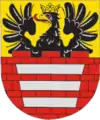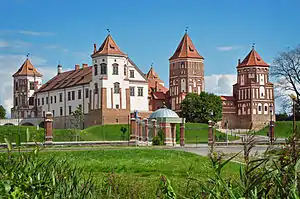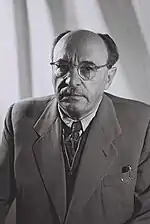Mir, Belarus
Mir (Belarusian: Мір; Russian: Мир; both meaning "world" and "peace"; but the name most likely originates from the name of the river the settlement is situated on) is a town in the Karelichy District (Карэліцкі раён) of Grodno Region, Belarus on the banks of Miranka River, about 85 kilometers southwest of the national capital, Minsk.
Mir | |
|---|---|
 | |
 Flag  Coat of arms | |
 Mir | |
| Coordinates: 53°27′N 26°28′E | |
| Country Subdivision | |
| Mentioned | May 28, 1434[1] |
| Time zone | UTC+3 (EEST) |
| • Summer (DST) | UTC+3 (EEST) |
| Area code(s) | +375-1596 |
History
Mir village was founded sometime prior to 1345. It is home to a late medieval castle, which made the town the target of many attacks over the centuries. The town belonged to the Illinič family (Korczak coat of arms) first and then to the Radziwiłł family. It was destroyed by the Swedish forces in 1655 (Deluge) and again by the Swedes during the Great Northern War in 1706. In 1792, the Lithuanian division of the Polish–Lithuanian Commonwealth army under Józef Judycki was routed by the invading Imperial Russian army corps under Boris Mellin (see Battle of Mir). During the Napoleonic invasion of Russia in 1812, Russian Imperial cavalry, artillery and cossack regiments ambushed and defeated the Duchy of Warsaw 3 uhlan divisions (Battle of Mir (1812)). The retreating Russians, withdrawing east, abandoned the town and destroyed the castle with gunpowder. During the Middle Ages it was first located in the Principality of Polotsk, after the Battle on the river Nemiga in the Principality of Minsk, then was taken over by Kievan Rus' but after the Mongol Invasion the Rus' rule diminished and since 1242 Mir belonged to the expanding and dynamic Duchy of Lithuania.
In 1569, along with the rest of the Grand Duchy of Lithuania, Mir became a part of the Polish–Lithuanian Commonwealth. In 1795, Mir was acquired by the Russian Empire as a result of the Third Partition of Poland.
From 1921 until 1939, Mir was part of the Second Polish Republic. On 17 September 1939, the town was occupied by the Red Army and, on 14 November 1939, incorporated into the Byelorussian SSR.
From 28 June 1941 until 7 July 1944, Mir was occupied by Nazi Germany and administered as a part of the Generalbezirk Weißruthenien of Reichskommissariat Ostland. After the end of German occupation, it remained within the Byelorussian SSR until 1991, when it became part of the independent Republic of Belarus.
Mir was the site of two very famous horse fairs associated with Saint Nikolaus feast days, first held on May 9 and the second fair on December 6 each year. Both fairs lasted four weeks each and were very popular and well known throughout the country until 1939. Roma practically dominated the fairs as horse traders, and numerous Roma community thrived in the town until 1939. The fairs collapsed in 1941, when Nazi Germany invaded the Belorussian Soviet Republic and murdered the Roma people of Mir.
Mir's claim to fame in Jewish Diaspora history is that it was the original home of the Mir yeshiva which operated there intermittently from 1815 until the fall of Poland in 1939, when the invading communist Soviet Red Army and security forces pressured the school to close and relocate to then still free Lithuania. (Current incarnations of the yeshiva are located in Brooklyn, New York, Jerusalem and Modi'in Illit.)
Today, Mir has little industry and is no longer an internationally renowned center of Jewish learning or Roma horse trade. Home to about 2,500 people, virtually none of whom are descended from the once thriving Jewish and Roma communities, its primary attraction is the Mir Castle as well as memorials erected by the Soviet government and various Jewish groups over the past half century. On the eve of World War II, some 2,400 Jews lived in Mir, about half of the town's population.[2] All of them, except about 50 escapees, were murdered by the Germans in 1941. One of the escapees, Elia Miranski, reported in an interview given in 2013 that entire neighborhoods had been destroyed by the Germans and the town today is significantly smaller than it was;[3] outlines of the former neighborhood streets can be seen on Google Earth to the northeast of the castle along the river.
Notable residents
- Zalman Shazar (1889–1974), Israeli author, poet, and third President of Israel from 1963 to 1973
See also
References
- Alieh Luckievič, edited by A. Januškievič (2014). "К вопросу о первом упоминании Мира в письменных источниках" (PDF). Minsk: 17, 22. Archived (PDF) from the original on 2016-03-15. Cite journal requires
|journal=(help) - "Mir, Poland (today Belarus)". yadvashem.org. Retrieved March 3, 2014.
- Gail Schwartz (interviewer) (May 19, 2013). "Oral history interview with Elia Miranski and Genia Miranski". United States Holocaust Memorial Museum. Retrieved March 4, 2014.
External links
| Wikimedia Commons has media related to Mir, Belarus. |


